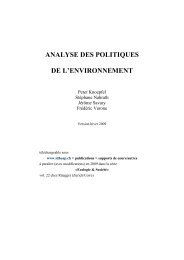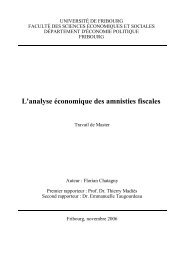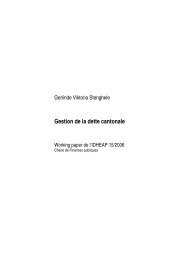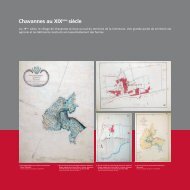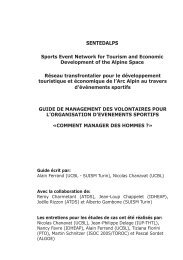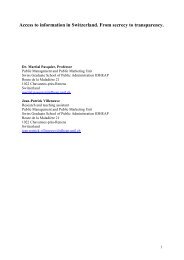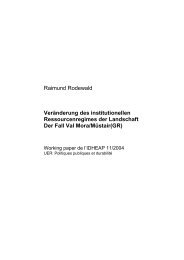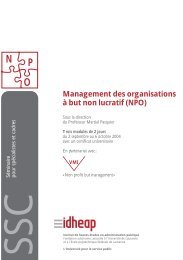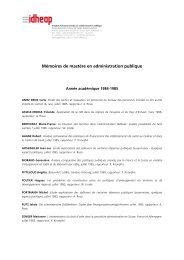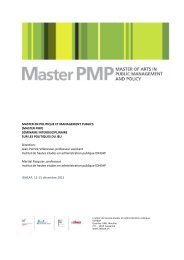Voting advice applications and party choice: evidence from ...
Voting advice applications and party choice: evidence from ...
Voting advice applications and party choice: evidence from ...
You also want an ePaper? Increase the reach of your titles
YUMPU automatically turns print PDFs into web optimized ePapers that Google loves.
<strong>Voting</strong> <strong>advice</strong> <strong>applications</strong> <strong>and</strong> <strong>party</strong> <strong>choice</strong> 377<br />
A further important (continuous) covariate that we take into account is age. We show,<br />
based on direct measurement, that the impact of smartvote on voting decisions decreases<br />
with the increasing age of the voters (see Table 1). This finding is supported by a<br />
previous study, which also found <strong>evidence</strong> that younger voters were more likely to be<br />
influenced by the voting recommendations in their vote <strong>choice</strong>s (Fivaz <strong>and</strong> Nadig, 2010,<br />
p.182). This could result <strong>from</strong> the fact that political preferences tend to become more<br />
consolidated with increasing age <strong>and</strong> are, thus, less amenable to newly encountered<br />
information. At the same time, younger users are more familiar with online-based<br />
communication <strong>and</strong> information <strong>and</strong> might, thus, be less sceptical with regard to its<br />
services. Whatever the case, similar mechanisms might be at play in terms of a higher<br />
tendency to adapt <strong>party</strong> preferences among younger voters. Hence, we not only expect<br />
that younger voters are more likely to adapt initial <strong>party</strong> preferences but we also expect<br />
age to condition the effect that the voting recommendations have on swing voting. In<br />
other words, the assumption is that the probability of swing-voting among those who<br />
were influenced by the voting recommendations compared to those who were not is<br />
higher among younger voters than among older voters. Therefore, we add an interaction<br />
term (age*influenced by voting recommendation) in our model to examine whether the<br />
influence of the voting recommendations on swing-voting is moderated by age.<br />
Further covariates that could boost the probability of vote change are political<br />
ideology <strong>and</strong> multiple vote propensities. Voters in the middle of the political spectrum<br />
are expected to be more inclined to switch between available parties. Multiple vote<br />
propensities measure whether a voter has an inclination to vote for more than one <strong>party</strong><br />
with a very high likelihood. The “vote propensity question” in election surveys asks<br />
voters to indicate the likelihood that they will ever vote for specific parties on an 11-point<br />
scale (Van der Eijk et al., 2006; Van der Eijk <strong>and</strong> Franklin, 2009). Those voters who<br />
indicate high likelihoods (vote propensities higher than 8) for one or more <strong>party</strong> besides<br />
their most preferred one are coded as voters with multiple vote propensities. This binary<br />
covariate is of utmost importance since it controls to some degree the fact that voters<br />
with several <strong>party</strong> preferences might be more inclined to swing-vote <strong>and</strong> more<br />
susceptible tothe services provided by VAAs. A binary measure for <strong>party</strong> attachment is<br />
included since we expect that strong <strong>party</strong> followers are less likely to adapt their vote<br />
intentions.<br />
To control for contextual circumstances, we included variables that measure the<br />
degree of competition in the different constituencies in Switzerl<strong>and</strong>. The ratio of<br />
competing c<strong>and</strong>idates per available seat indicates the degree of variation for <strong>choice</strong>s – the<br />
higher the competition is for the available seat, the bigger the <strong>choice</strong> set <strong>and</strong> the higher<br />
the probability are for deciding on a c<strong>and</strong>idate <strong>from</strong> a different <strong>party</strong>. Thus, we controlled<br />
for the variation within cantons by including 14 dummies for the 15 different district<br />
magnitudes in our model. We also controlled for socio-demographic indicators such as<br />
gender, education, <strong>and</strong> income. Table 5 contains the corresponding results (the full model<br />
including all 14 dummies <strong>and</strong> 15 district seizes is attached in the Appendix A).<br />
In logistic regressions with interactions present, the interpretation of the results<br />
differs substantially <strong>from</strong> a regular regression. Without elaborating on the technicalities<br />
behind it (cf. Norton et al., 2004), the sign <strong>and</strong> the significance of the interaction<br />
coefficient <strong>and</strong> the corresponding single coefficients cannot be directly interpreted <strong>from</strong><br />
the model. Thus, as recommended by Long <strong>and</strong> Freese (2006), we plot predicted<br />
probabilities based on the main variables of interest <strong>and</strong> their interaction (influenced by



